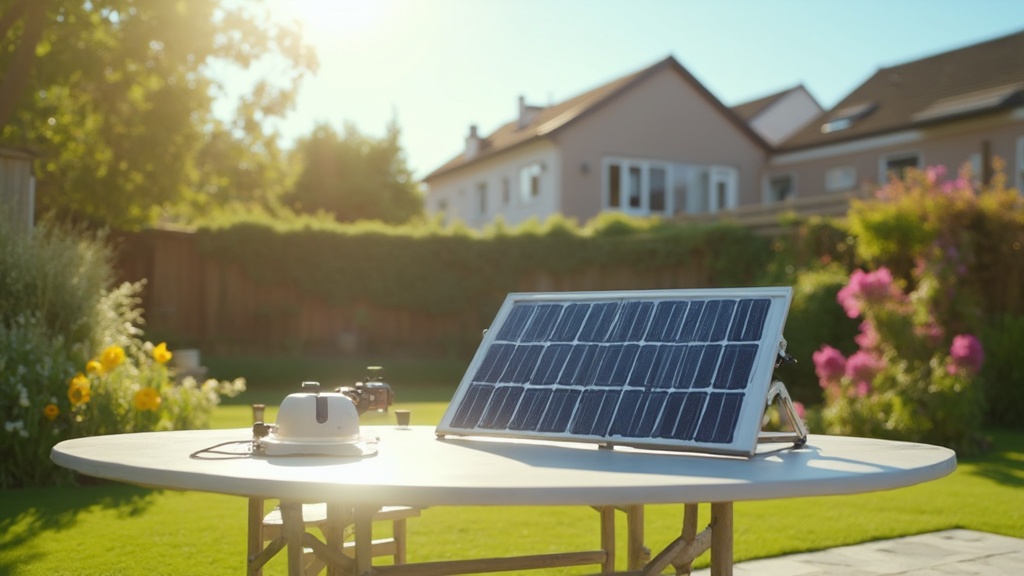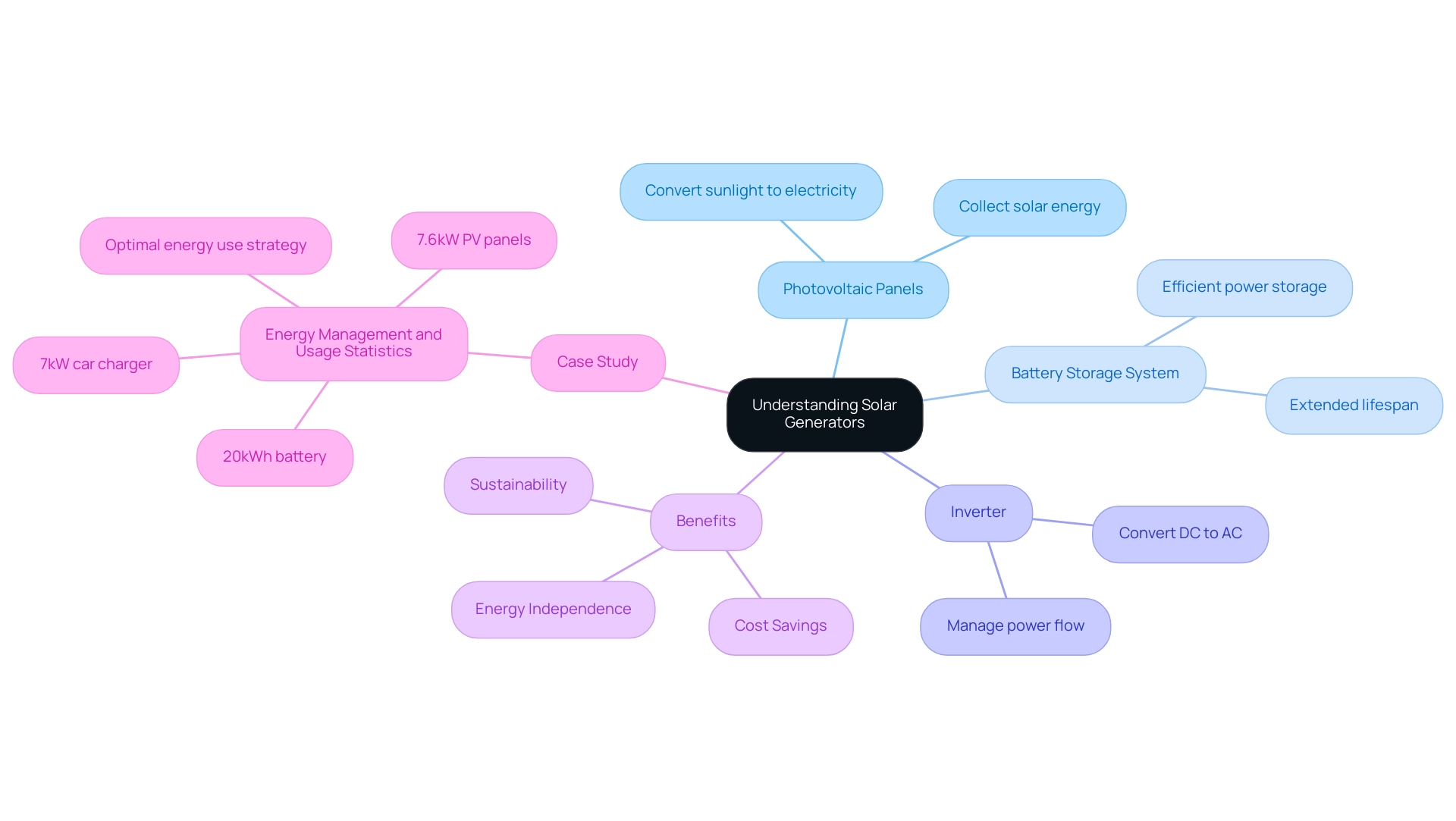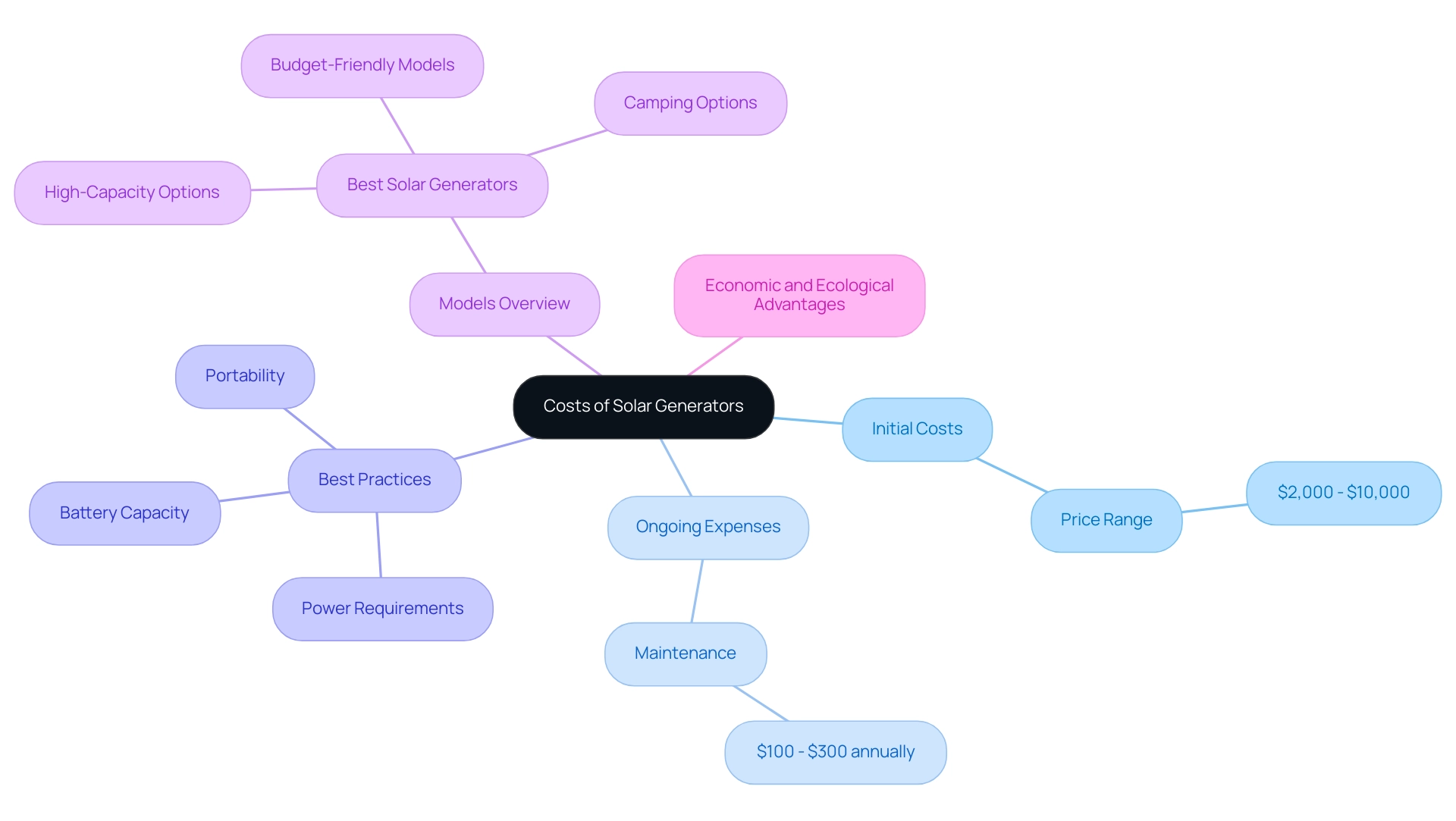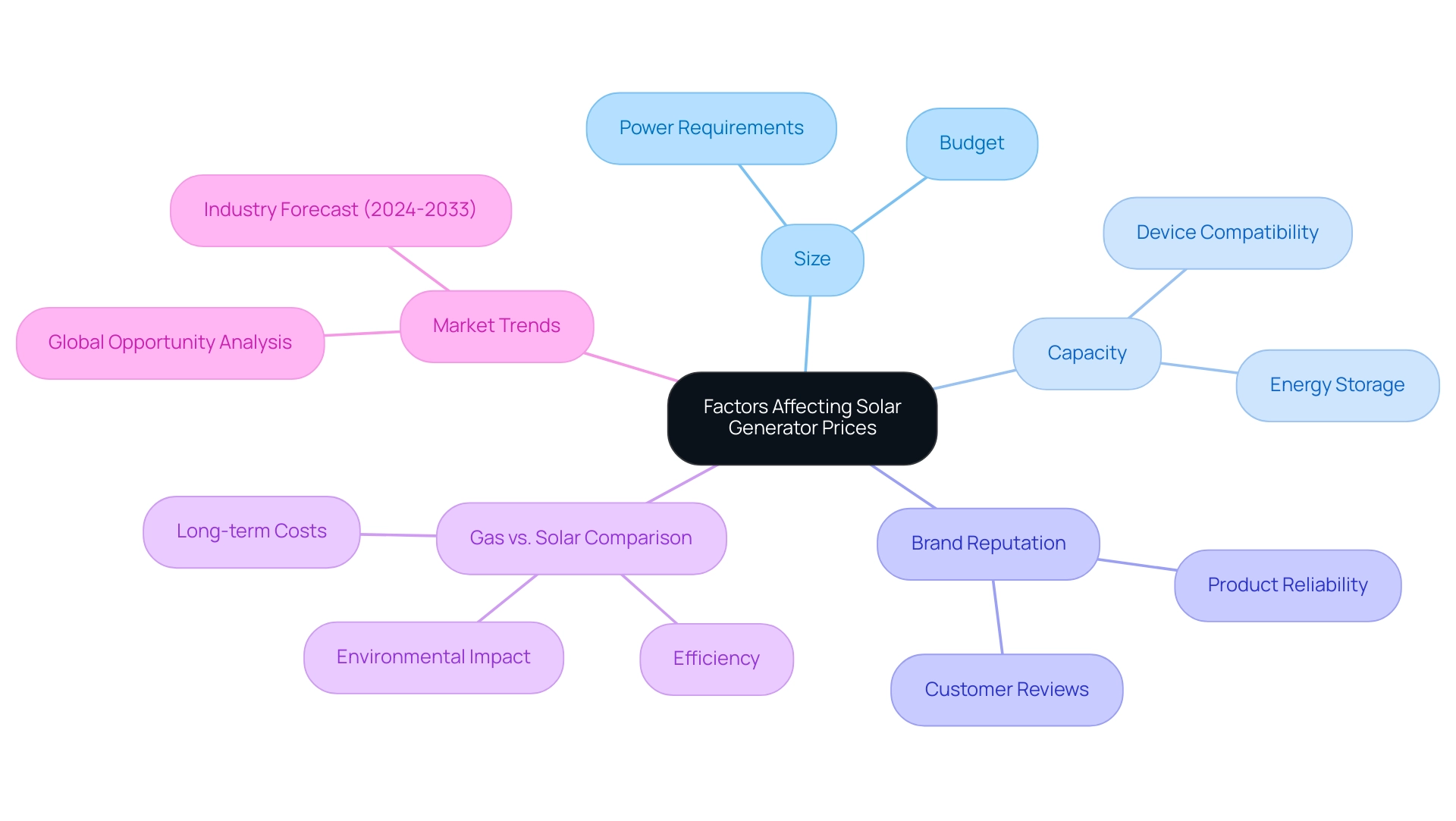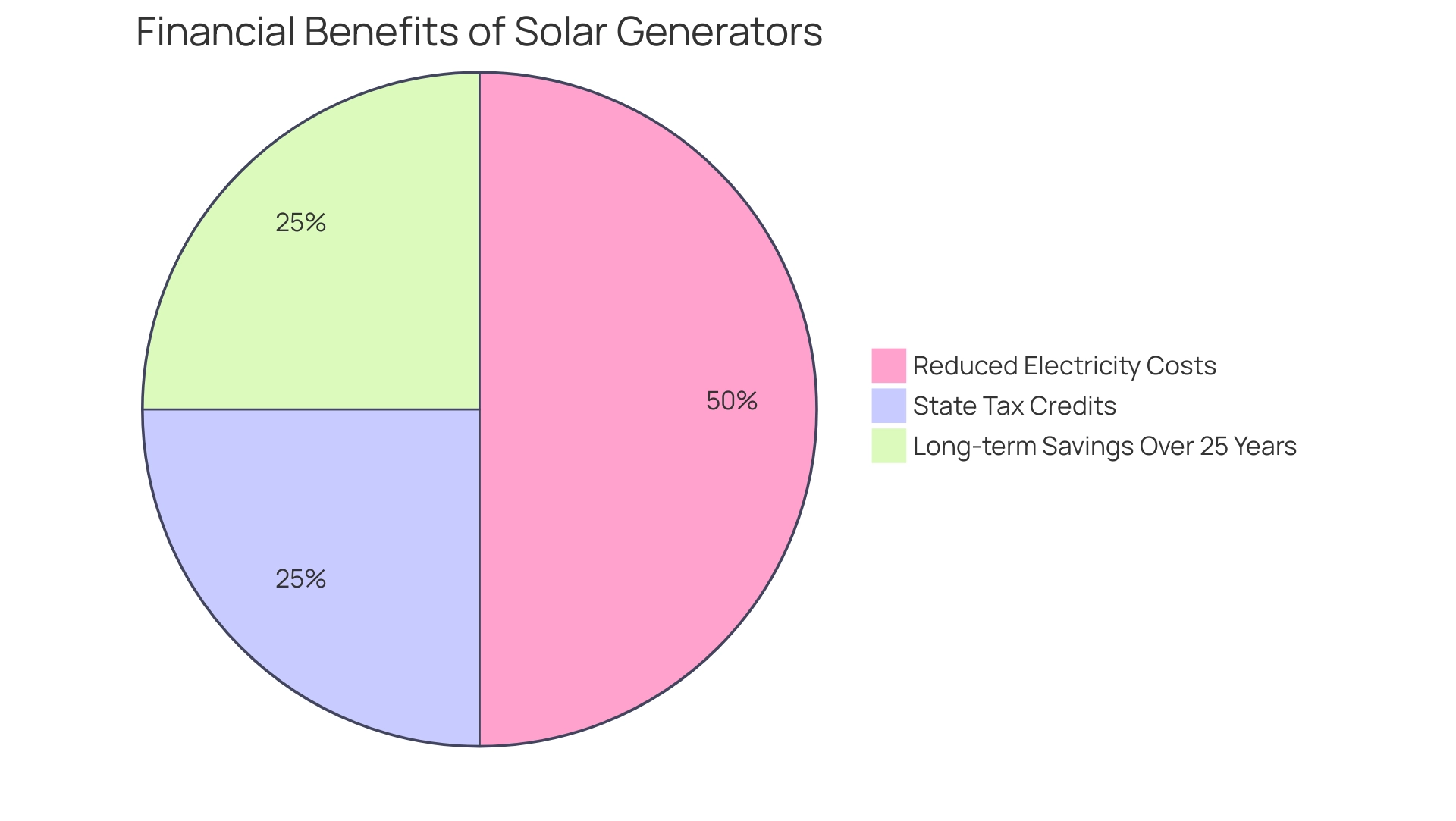Overview
The article provides a comprehensive guide on calculating the costs associated with solar generators, detailing both initial and ongoing expenses, which typically range from $2,000 to $10,000 depending on the system’s size and capacity. It emphasizes the importance of considering factors such as installation costs, maintenance, and available government incentives, which can significantly reduce the overall financial burden and enhance the investment’s long-term savings potential.
Introduction
As the world shifts towards more sustainable energy sources, solar generators have emerged as a beacon of hope for homeowners eager to reduce their reliance on traditional power grids. These innovative devices capture sunlight and convert it into electricity, offering a practical solution for powering everything from essential appliances to electric vehicles.
With the potential to save significantly on energy bills while contributing to a greener planet, understanding how solar generators work and the factors influencing their costs is crucial. From evaluating the initial investment to exploring ongoing expenses and financial benefits, homeowners can make informed decisions that align with their eco-friendly goals.
This comprehensive guide will delve into the ins and outs of solar generators, helping to illuminate the path toward a more sustainable and cost-effective energy future.
Understanding Solar Generators: What They Are and How They Work
Solar generators are fantastic devices that harness the power of the sun to create electricity, allowing you to run various appliances without traditional power sources. They usually consist of three vital elements:
- Photovoltaic panels
- A battery storage system
- An inverter
The photovoltaic panels collect sunlight and convert it into electrical power, which is then stored in batteries for use when the sun isn’t shining.
This arrangement is particularly beneficial for homeowners keen to reduce their reliance on the grid and cut costs on utility bills while aiding in the preservation of a more sustainable planet. Did you know that in 2020, only 133 terawatt-hours of sunlight power were generated in the U.S., despite the capacity for an astonishing 386,646 terawatt-hours? Moreover, the renewable energy sector needs hundreds of gigawatts of new capacity additions in the next 10 years to meet America’s emissions reduction goals, highlighting the urgency of embracing this technology.
A practical example can be seen in a recent case study involving a household equipped with:
- 7.6kW PV panels
- A 20kWh battery
- A 7kW car charger
This household aims for optimal power use by charging the battery with excess PV generation during the day and utilizing cheaper grid electricity at night, showcasing how strategic management can lead to significant cost savings and sustainability benefits. Comprehending how these elements function collectively not only emphasizes the advantages of renewable power systems but also underscores the significance of investing in a generator for a more sustainable future.
When evaluating battery choices, homeowners should explore high-capacity lithium-ion batteries, which provide efficient power storage and extended lifespans. Furthermore, comprehending the 200% Rule can assist homeowners in optimizing their panel sizes and power generation, guaranteeing they can efficiently satisfy their power requirements. As Ben Zientara, a highly regarded policy analyst for renewable resources, highlights, adopting this technology is not merely a wise decision—it’s an essential move towards a cleaner power landscape that fosters economic development and job creation in the sustainable sector.
Furthermore, initiatives aimed at equitable access to renewable technology can ensure that all homeowners, regardless of income level, can benefit from energy solutions.
Breaking Down the Costs of Solar Generators: Initial and Ongoing Expenses
When exploring the realm of photovoltaic systems, it’s crucial to comprehend how much a solar generator costs in terms of initial expenses involved. Typically, when asking how much is a solar generator cost, you’re considering a range between $2,000 and $10,000 for a complete setup that includes panels, batteries, an inverter, and installation. This investment can effectively energize your appliances, with devices around 2,400 W and 2,000 Wh able to operate all the essentials in an RV with daily sunlight recharging.
The final price tag, which includes how much is a solar generator cost, will largely depend on the size and capacity you choose to meet your specific needs. But don’t forget about the ongoing expenses—maintenance usually runs between $100 and $300 annually, which is manageable for many eco-conscious homeowners. Furthermore, it’s essential to take best practices into account when choosing a renewable energy device. Elements such as power requirements, portability, and battery capacity should influence your choice.
A recent roundup titled ‘Best Energy Machines Overview’ highlights a variety of models tailored for different needs, showcasing the significant advancements in energy technology that make them not just practical for everyday use but also for emergencies.
As Ben Zientara, a Power Policy Analyst, aptly puts it, ‘With a collapsible pull handle and heavy-duty wheels, this thing is like a giant YETI cooler, except instead of beverages and ice, it’s filled with go-juice that makes all your electronics come alive.’ By comprehending these expenses and alternatives, including the economic and ecological advantages of renewable technologies, you can more effectively organize your budget and feel assured in your investment in clean power solutions for your home, contributing to both financial savings and environmental sustainability.
Factors Affecting Solar Generator Prices: Size, Capacity, and Brand Considerations
When evaluating how much is a solar generator cost, several crucial elements can greatly affect your decision-making process. First and foremost, size and capacity are crucial; naturally, larger systems designed to power more devices will influence how much is a solar generator cost. It’s crucial to find the right equilibrium between your power requirements and your budget, particularly given that your electrical panel should be at least 200 amps to accommodate alternative energy systems.
The pricing of a solar generator is significantly influenced by brand reputation, which raises the question of how much is a solar generator cost. For instance, the recently launched Bluetti NA300, known for its thermal stability and fast charging capabilities, is celebrated for its reliability and premium features, justifying its higher price point.
In comparing gas vs. solar-powered devices, solar-powered units often provide greater efficiency and lower long-term operational costs, as they utilize renewable energy from the sun, reducing reliance on fossil fuels. While gas generators can provide power on demand, they incur ongoing fuel costs and have a higher environmental impact due to emissions. Understanding panel efficiency on cloudy days is critical for homeowners; even under less-than-ideal conditions, these panels can still generate power, though at reduced levels.
This comprehension can assist you in evaluating the total worth of renewable energy projects. Take the time to compare different models, read customer reviews, and gather insights about long-term value. Furthermore, a recent report on the Solar Generator Market provides insights into how much is a solar generator cost while offering a global opportunity analysis and forecasts industry trends from 2024 to 2033, which could impact pricing strategies.
By taking into account these factors and the benefits of renewable technology compared to gas-powered systems, you can ensure that your investment in clean alternatives not only satisfies your power needs but also aligns with your environmentally-friendly objectives and contributes positively to the ecosystem.
Evaluating the Financial Benefits: How Much Can You Save with a Solar Generator?
Investing in a renewable generator is not just a decision; it’s a step towards a sustainable future, offering impressive savings over time for eco-conscious homeowners. By comprehending residential photovoltaic panel dimensions and the advantages under the 200% Rule, you can customize your power solutions to maximize savings. For example, homeowners such as the Smiths in California decreased their electricity expenses by 50% after setting up a panel system that met the 200% Rule, enabling them to produce more power than they use.
Imagine the relief of watching those monthly expenses shrink! Additionally, many states are enhancing incentives and rebates for renewable energy projects, significantly reducing your initial expenses. In New York, for instance, property owners can get up to 25% back on their renewable energy expenditures through state tax credits, making it more attainable than ever.
Over the lifespan of your energy generator—often exceeding 30 years—you can expect substantial long-term savings, with potential savings from installing a panel system exceeding $100,000 over 25 years. As you consider this investment, assessing these financial advantages will assist you in understanding the real worth of utilizing renewable energy. Furthermore, the growing demand for photovoltaic systems paired with battery storage reflects a strong trend in the market, driven by state incentives and changing policies.
With the worldwide photovoltaic sector anticipated to expand from $189.5 billion in 2022 to $607.8 billion by 2030, it’s evident that sunlight power is not merely a fad; it’s a lasting remedy that benefits your finances and the ecosystem for years ahead. At Powercore Electric, we provide a variety of services to assist you in saving, storing, and safeguarding your home simultaneously, ensuring you can maximize the benefits of your energy system!
Budgeting for Your Solar Generator: Tips for Planning Your Investment
When planning for a renewable energy source, the initial step is to evaluate your energy requirements and decide your comfort level for spending. Take some time to research the various power generator models and how much is a solar generator cost to familiarize yourself with what’s available. Remember, it’s important to consider how much is a solar generator cost, including not just the initial purchase price, but also installation costs and potential maintenance expenses over time.
Fortunately, numerous homeowners can take advantage of government subsidies that might cover a portion of the overall expense for installing renewable energy systems, leading many to ask how much is a solar generator cost, making this expenditure even more attractive. To take advantage of these programs, homeowners should explore local and federal incentives, such as tax credits or rebates, which can significantly reduce upfront costs.
As you navigate this process, consider exploring financing options like loans or leasing programs to help you determine how much is a solar generator cost, which can ease your initial investment. It’s also a good idea to set aside a contingency fund for any unexpected expenses that might arise during installation or afterward. For instance, a case study titled “Financial Viability of Solar Generators” highlights how investing in photovoltaic generators can lead to significant long-term savings on electricity bills, largely thanks to government incentives.
To understand how photovoltaic panels function, it’s essential to know that they convert sunlight into electricity using photovoltaic cells. This process not only produces power for your home but can also send surplus electricity back into the grid, potentially earning you credits on your utility bill. Dan Weeks, vice president of business development at ReVision Energy, highlights that “Photovoltaic systems decrease a company’s dependence on fossil fuels and aid in offsetting its shift to electric vehicles,” which connects these advantages directly to the financial benefits of renewable energy initiatives.
By planning ahead and considering these factors, you can ensure that your investment in a solar generator takes into account how much is a solar generator cost, making it not only financially sensible but also perfectly aligned with your energy needs, paving the way for a more sustainable future.
Conclusion
Investing in a solar generator is a powerful step toward embracing a more sustainable lifestyle while also reaping significant financial rewards. By understanding how solar generators operate—from their core components to the various factors influencing their costs—homeowners can make informed decisions that align with their energy needs and eco-friendly goals. The potential savings on electricity bills, coupled with available incentives and rebates, make solar energy an attractive option for those looking to reduce their reliance on traditional power sources.
As explored throughout the article, the initial investment in solar technology can vary, but the long-term benefits often outweigh the upfront costs. Homeowners can achieve substantial savings over the lifespan of their solar systems, with many seeing reductions in their energy expenses by as much as 50%. Furthermore, the growing demand for solar solutions and innovations in technology signal a bright future for renewable energy, making it a wise choice not just for the environment but also for personal finances.
Ultimately, embracing solar energy is not merely a trend; it represents a significant shift toward a cleaner, more sustainable energy landscape. By taking the time to evaluate options, understand costs, and explore financing opportunities, homeowners can confidently invest in solar generators, ensuring they contribute positively to both their wallets and the planet for years to come.


